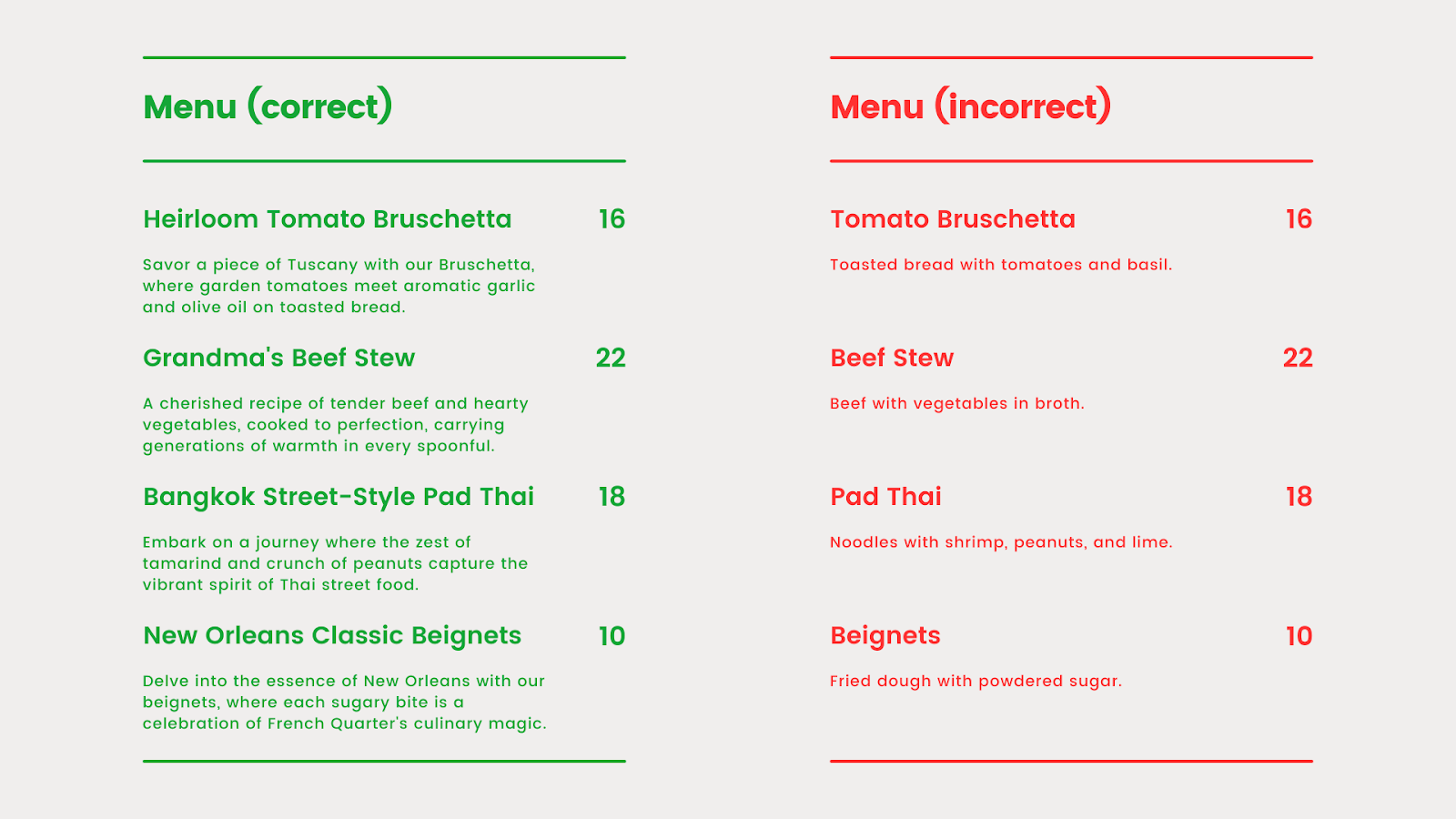Beyond listing dishes, menu descriptions can elevate your customers' dining experience to new heights. These descriptions link what's in the kitchen and what ends up on the table. Menu descriptions have the power to entice the senses and create cravings that keep them coming back for more. In this blog, we explore how to write menu descriptions that not only engage the senses but also enhance the overall dining experience.
Benefits of Writing Good Menu Descriptions
Increased Restaurant Sales
Well crafted menu descriptions can actually significantly boost your restaurant's sales. By using the right tactics you're not just describing dishes, you're creating cravings. When your customers can practically taste, smell, and see the dish through your words, they're more likely to order it, not just once but time and time again.
Enhance Your Dining Experience
Writing great menu descriptions can create a more enjoyable dining experience for your customers. For example, some customers will appreciate the transparency of categorizing and labeling menu items, making it easier for them to find dishes that match their preferences. Menu descriptions also create backstory, intrigue and excitement which all lead to an enhanced dining experience.
Increase Customer Satisfaction and Loyalty
When you cater your menu descriptions to your target audience, you're crafting an experience tailored to your customers’ tastes and preferences which in turn, increases customer satisfaction and loyalty.
Tips for Writing Mouthwatering Menu Descriptions
Use Menu Descriptions to Engage Your Customers Senses
When it comes to creating irresistible restaurant menu descriptions, one part you absolutely shouldn't forget about is engaging your customers' senses. Think about it, when people explore your menu, they want more than just a list of dishes. They want to embark on a sensory journey. Sensory descriptions add depth and flavor to your menu items, allowing diners to almost taste, smell, and see the dish before it even arrives at their table. It’s important to ensure you’re targeting different senses as then you're not just appealing to one set of receptors, you're creating a full on experience. Below are some examples of correct and incorrect menu descriptions for the senses.

Tell a Story Through Your Menu Descriptions
Writing menu descriptions can be thought of as sharing stories with your customers. It's not only about listing what's in the dish; it's about painting a tasty picture that gets their mouths watering. Imagine sitting across from a friend, describing that mouthwatering lasagna like you're reminiscing about a trip to Italy or a family gathering. You want your customers to feel that connection, whether it's the comfort of home-cooked meals or the excitement of new flavors. To incorporate storytelling into your menu descriptions you could start by talking about the dish’s creators, its history or how your restaurant specifically makes the dish. Here is an example of correct and incorrect storytelling menu descriptions.

Integrate Adjectives into Your Descriptions
Including adjectives in your menu descriptions is kind of like giving your dishes a personality. Think about it, when you read "juicy grilled chicken" versus just "grilled chicken," which one gets your mouth watering more? Adjectives add flavor to your menu items without you having to add extra ingredients. Whether it's "crispy golden-brown fries" or "rich velvety chocolate mousse," they paint a picture in your customers' minds. Here are some more examples of adjectives you can include in your menu descriptions:
- Crispy
- Tender
- Zesty
- Fragrant
- Luscious
- Smoky
- Juicy
- Melt-in-your-mouth
- Golden-brown
- Flavorful
- Creamy
- Spicy
- Rich
Categorize and Label Your Menu Items
Categorizing and labeling your menu items creates an easy to navigate menu for your diners, ensuring they can easily find the dishes that match their preferences and dietary needs. Whether it's designating dishes as "vegetarian" for those who prefer plant-based options or "gluten-free" for those with dietary restrictions, these labels guide your customers to the flavors they want. It's a way to make your menu more inclusive, showing that you've thought of everyone's dining experience. So, whether your customers are vegetarian, gluten-sensitive, or just craving something specific, these categories and labels help them find their perfect dish and ensure a satisfying and seamless dining experience.
Keep Your Menu Descriptions Simple
While you’re creating your menu descriptions it’s important to remember to keep them simple and easy to digest. It's all about making the dining experience as straightforward and enjoyable as possible. Instead of overwhelming your customers with unnecessary language, choose concise and easy to understand descriptions that highlight the key elements, while still getting your point across. When you keep it simple, diners can quickly grasp what they're ordering, leading to more confident choices and a more satisfying meal.
Cater Your Menu to your Target Audience
Knowing your target audience is one of the most important pieces of information when it comes to marketing and presenting your restaurant, and this includes your menu. Catering to your target audience is about crafting a menu that speaks directly to their tastes and preferences. If your crowd loves hearty comfort food, go big on those comforting classics. If you're in a health-conscious neighborhood, make sure you've got some nutritious options. Customizing your menu to make everyone feel right at home will help you keep them coming back for more.
Proofread Your Menu Descriptions
Last but far from least, proofreading your menu description is a crucial step. Imagine spotting a glaring typo or grammar hiccup right in the middle of your menu – not so appealing, right? Take a moment to give your descriptions a once-over, and if you can, get a fresh pair of eyes to help. Even gathering feedback from your target audience may be helpful to narrow down your offerings and descriptions.


.jpg)


.jpg)